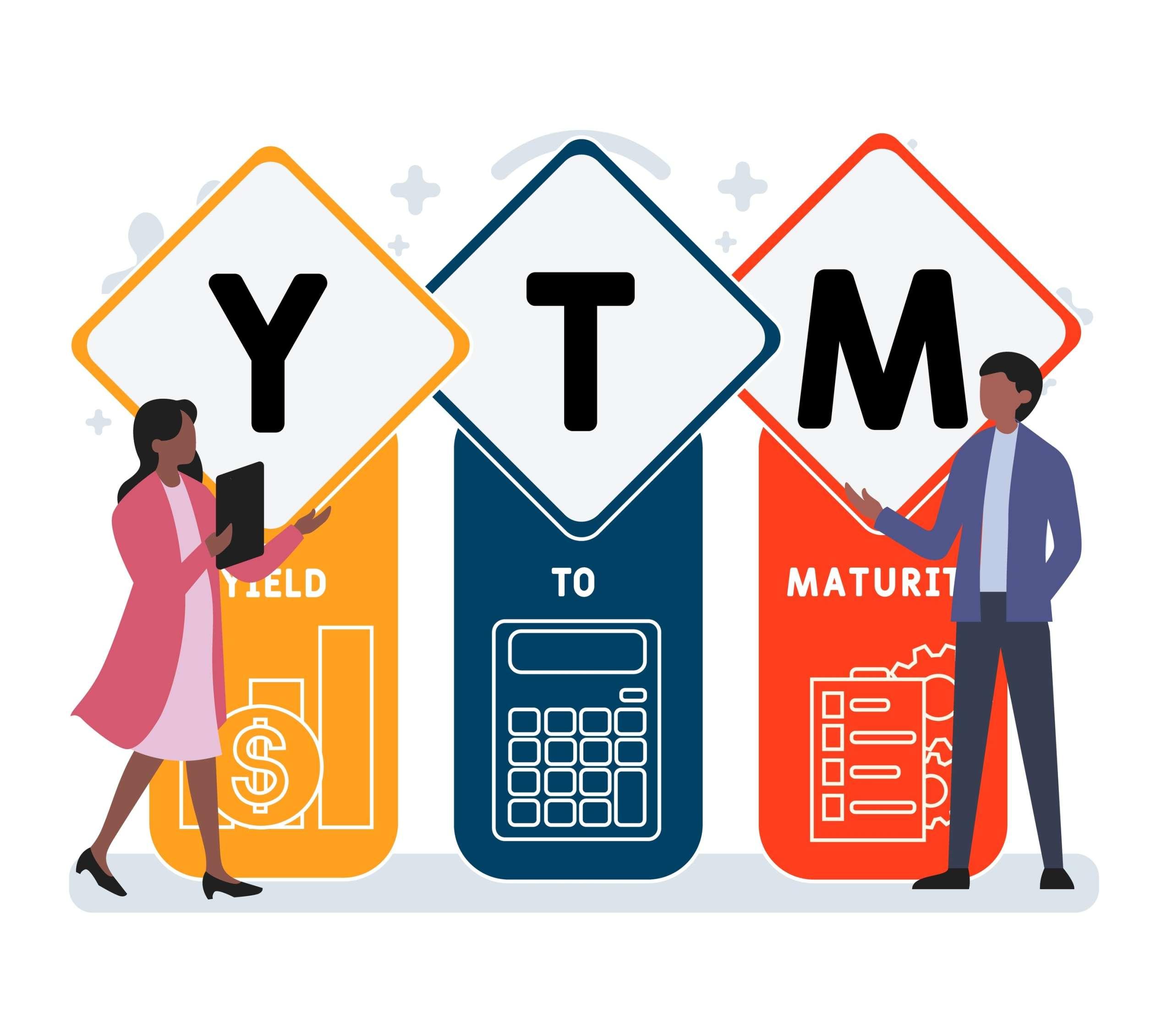If you have been exploring the world of bonds and fixed-income investments, you would have undoubtedly come across the term "Yield To Maturity" (YTM). YTM is a fundamental concept in bond investing, offering a snapshot of the potential returns an investor might expect from a bond. But what exactly is it, how is yield calculated and why is it so essential to understand? Let's dive in!
What is Yield to Maturity (YTM)?
In the simplest terms, yield to maturity (YTM) is the total annual return an investor expects to earn if a bond or other fixed-income security is held until it matures. It is a critical gauge for investors as it helps assess the overall profitability of their investment, taking into account both the interest payments received and any capital gain or loss if the bond is purchased at a price different from its par value.
YTM is especially crucial when it comes to mutual funds. The yield to maturity in a mutual fund gives investors a more accurate picture of the returns they might see compared to a simple current yield calculation. It factors in not just the interest earned, but also any changes in the market price of the securities in the fund. Thus, if you are keen on making informed investment decisions, understanding YTM becomes even more vital.
Yield to Maturity Formula
So, how is yield calculated? And what is the yield to maturity formula?
Yield to maturity is a complex calculation that takes into account several variables: the bond’s current market price, its face value, its maturity date and the interest rate, or coupon rate, that it pays annually.
In mathematical terms, YTM is the discount rate that equates the present value of a bond's future cash flows to its current market price. The yield to maturity formula can be represented as follows:
YTM = C + [(F-P)/n] / [(F+P)/2]
Where:
• YTM is the yield to maturity
• C is the annual coupon payment
• F is the face value of the bond
• P is the purchase price of the bond
• n is the number of years until maturity.
This formula tells us that the YTM is the sum of the bond’s annual coupon payment and its average annual capital gain or loss. However, keep in mind that this formula assumes that all future coupon payments can be reinvested at the YTM rate, which might not always be the case in real life.
How to Calculate Yield to Maturity?
To calculate Yield to Maturity, you need to use the YTM formula discussed above. Let’s see an example to understand YTM calculation-
Say, a bond has a market price of Rs. 800 and a face value of Rs. 1000. For this particular bond, the annual coupons are Rs. 200 and the coupon rate is 10% at a maturity period of 5 years.
Then, YTM= [200 + {(1000-800)/5}] / [(1000+800) / 2]
= [(200 + 200/5) / 1800/2] = [200 + 40 / 900]
= 240/900 = 26.67%
Why is Yield-to-Maturity Useful
Yield-to-maturity (YTM) is an important measure for bond investors because it provides an estimate of the total return you can expect if you hold a bond until it matures. It considers the bond's current market price, its coupon payments, and the time remaining until maturity.
Essentially, YTM helps you compare different bonds and make informed investment decisions. By understanding YTM, you can assess a bond's potential profitability relative to other bonds with different coupon rates, maturities, and prices.
Here's why YTM is useful:
Comparison: YTM allows you to compare the potential returns of different bonds, even if they have varying coupon rates and maturities. This helps you identify which bonds offer the most attractive yields based on your investment goals.
Pricing: Helps you understand if a bond is priced attractively in the market relative to its potential return. A higher YTM compared to similar bonds suggests the bond might be undervalued, while a lower YTM could indicate overvaluation.
Portfolio Management: By calculating the YTM of individual bonds in your portfolio, you can assess the overall yield of your bond holdings.
Interest Rate Changes: YTM can help you anticipate how changes in prevailing interest rates might affect your bond's value. If interest rates rise, the YTM of existing bonds will generally increase.
Uses of YTM
Understanding the practical uses of YTM is fundamental to making informed investment decisions. The concept, while intricate, provides essential information that assists investors in comparing and analysing bonds and fixed-income securities. Here are some practical applications of YTM:
Comparative Analysis of Bonds
YTM allows investors to conduct a comparative analysis of various bonds in the market. If an investor is considering two bonds with different coupon rates and market prices, YTM can be used to compare them on an equal footing. It provides a comprehensive understanding of the total return from each bond, taking into consideration both the periodic interest payments and the potential gain or loss if the bond is bought at a price different from its face value.
Making Investment Decisions
The calculation of YTM plays a significant role in deciding whether to invest in a bond or not. If the YTM of a bond is higher than the investor's required rate of return, the bond could be a potential investment opportunity. Conversely, if the YTM is less than the required return, the investor may choose to look for other more profitable investment options.
Assessing Interest Rate Risk
YTM can help investors assess the interest rate risk associated with a bond. Bonds with longer maturities are more exposed to interest rate risk. If the interest rates rise, the bond's price falls, reducing the bond's market value. Conversely, if the interest rates fall, the bond's price rises. By assessing YTM, an investor can better understand how changes in interest rates might affect their potential returns.
Evaluating Mutual Fund Performance
Yield to maturity is also vital when considering investments in bond mutual funds. These funds invest in a variety of bonds, each with its own YTM. The fund's overall YTM, which is a weighted average of the YTM of each bond in the fund, gives a clearer picture of the fund's potential returns. An investor can compare the YTM of various bond funds to determine which might offer better returns.
Understanding Bond Pricing Trends
YTM is inversely related to bond prices. When bond prices go up, YTM goes down and vice versa. By tracking YTM, investors can gain insights into bond pricing trends and anticipate potential market movements.
Limitations of Yield to Maturity
While Yield to Maturity (YTM) is a useful metric for assessing bond returns, it has certain limitations that you must consider. Firstly, YTM calculations do not consider the taxes you will pay on all the bonds. In essence, YTM is considered the gross redemption profit/yield.
Secondly, yield of maturity and current yields are simply estimates, so they are not always reliable to determine the accurate returns. Instead, the bond returns depend on the bond’s price when sold.
Conclusion
As we wrap up this detailed examination of yield to maturity, we can affirm its undeniable importance in the realm of investing. Understanding YTM is like having a financial compass that points you in the right direction when making investment decisions.
In terms of practical application, Tata Capital extensively uses the concept of YTM. As a part of their lending business, they purchase corporate bonds and other fixed-income securities as an investment and to maintain a diversified portfolio.
In summary, understanding and effectively leveraging the concept of yield to maturity can lead to more informed and strategic financial decisions. Whether you are an individual investor or a large financial institution like Tata Capital, mastery of YTM can significantly enhance your capacity to navigate the financial landscape with confidence and precision. Keep expanding your knowledge on our investment app , continue to be an informed investor and witness your financial growth journey soar.
FAQs on Yield to Maturity
What is the meaning of YTM?
YTM stands for Yield-to-Maturity. It's the total return anticipated on a bond if you hold it until its maturity date, taking into account its current market price, coupon payments, and the time left until it matures.
What is the effective yield?
Effective yield, also known as annual percentage yield (APY), represents the actual annual rate of return on an investment, considering the effect of compounding.
What is YTW?
YTW stands for Yield-to-Worst. It's the lowest potential yield you could receive on a callable bond, considering the possibility that the issuer might redeem the bond before its maturity date.
What is YTC?
YTC stands for Yield-to-Call. It's the yield you can expect on a callable bond if the issuer decides to redeem it at its call price before the maturity date.
What is the difference between bond yield and YTM?
Bond yield refers to the return a bond generates, often expressed as the current yield. Yield to Maturity (YTM) considers all future cash flows, including interest and principal repayment, providing a better measure of a bond’s total return.
Why is YTM important?
YTM helps investors assess the total expected return of a bond if held until maturity. It accounts for interest payments and reinvestment rates, making it a crucial metric for comparing different bonds and making informed investment decisions.
What is the biggest benefit of using YTM over current yield?
YTM is more comprehensive than current yield as it factors in the bond’s purchase price, coupon payments, and maturity value. This gives a clearer picture of the bond’s actual return, especially for bonds trading at a premium or discount.
What happens if yield to maturity increases?
If YTM increases, the bond’s price typically falls, making it cheaper for new investors but reducing the value of existing holdings.
Should the YTM be high or low?
A high YTM can indicate higher returns but may come with greater risk, such as credit or interest rate risks. A low YTM suggests stability but lower returns. The ideal YTM depends on an investor’s risk tolerance and financial goals.
Popular Searches
Learn Center
Mutual Fund Investment
Calculators
 9 mins read
9 mins read
 Previous Post
Previous Post



















